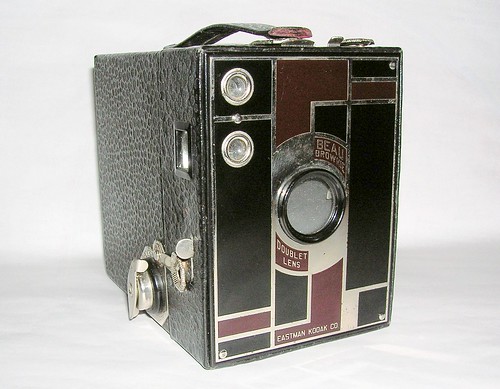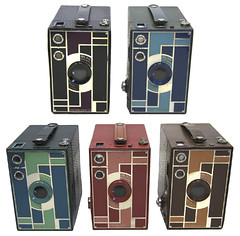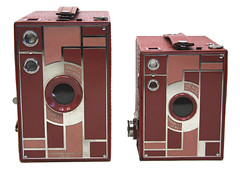Difference between revisions of "Kodak Beau Brownie"
(added images, slightly more description) |
m (typo, earlier withdrawal of rose & green models) |
||
| Line 6: | Line 6: | ||
}} | }} | ||
| − | [[Kodak]]'s '''Beau Brownie''' exists in two models: N°2 Beau Brownie (for [[120 film]]; this | + | [[Kodak]]'s '''Beau Brownie''' exists in two models: N°2 Beau Brownie (for [[120 film]]; this is the model photographed above, in black) and the slightly larger N°2A Beau Brownie (for [[116 film]]). The two models appeared in October 1930 and disappeared in 1933, although the green and rose models were withdrawn earlier, in 1931. Their front faces are made of two-tone enamel. The geometrical figures are typical style Art Déco. They are due to the designer [[Walter Dorwin Teague]]. The possible colors are black, pink, blue, green and tan. The metal body is covered with imitation leather. The only adjustments were I & B shutter speeds and three choices of aperture, given by sliders on the top edge. |
Revision as of 00:55, 15 April 2008

|
| Kodak Nr. 2 Beau Brownie by Jerónimo- Jerome Girolamo |
Kodak's Beau Brownie exists in two models: N°2 Beau Brownie (for 120 film; this is the model photographed above, in black) and the slightly larger N°2A Beau Brownie (for 116 film). The two models appeared in October 1930 and disappeared in 1933, although the green and rose models were withdrawn earlier, in 1931. Their front faces are made of two-tone enamel. The geometrical figures are typical style Art Déco. They are due to the designer Walter Dorwin Teague. The possible colors are black, pink, blue, green and tan. The metal body is covered with imitation leather. The only adjustments were I & B shutter speeds and three choices of aperture, given by sliders on the top edge.
EXTERNAL LINKS

|
| Five colours of Beau Brownie by Rick Soloway |

|
| No.2A and No.2 size comparison by Rick Soloway |